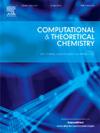Theoretical study of novel xanthene-linked L-(D-π-a)2-type double-anchored dyes for dye-sensitized solar cells: Effects of π bridge length and TiO2 adsorption pattern
IF 3
3区 化学
Q3 CHEMISTRY, PHYSICAL
引用次数: 0
Abstract
To investigate the effects of varying π bridge lengths on the structural and electronic properties, two L-(D-π-A)2-type dye molecules were simulated using density functional theory (DFT). In this study, KS-19 employed thiophene as the π bridge, while KS-21 incorporated 2,2′-bithiophene. The optimized geometry revealed that the presence of 2,2′-bithiophene in the KS-21 molecule enhances its degree of conjugation, thereby exhibiting superior molecular stability. The additional thiophene unit in KS-21 was found to facilitate a red shift in the absorption spectra based on optical property analysis. Furthermore, 2,2′-bithiophene within the KS-21 molecule proved more effective for achieving dye regeneration and complete electron injection. Additionally, we simulated their adsorption behavior on titanium dioxide clusters and calculated their adsorption energies. Our investigation demonstrated that the KS-21 dye with a 2,2′-bithiophene π spacer exhibited enhanced photovoltaic performance. Consequently, double-anchored dyes incorporating extended π conjugated structures show significant promise across various applications in dye-sensitized solar cells.

求助全文
约1分钟内获得全文
求助全文
来源期刊

Computational and Theoretical Chemistry
CHEMISTRY, PHYSICAL-
CiteScore
4.20
自引率
10.70%
发文量
331
审稿时长
31 days
期刊介绍:
Computational and Theoretical Chemistry publishes high quality, original reports of significance in computational and theoretical chemistry including those that deal with problems of structure, properties, energetics, weak interactions, reaction mechanisms, catalysis, and reaction rates involving atoms, molecules, clusters, surfaces, and bulk matter.
 求助内容:
求助内容: 应助结果提醒方式:
应助结果提醒方式:


